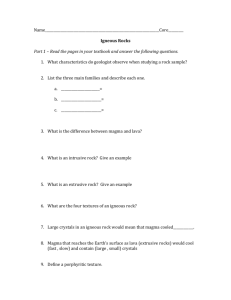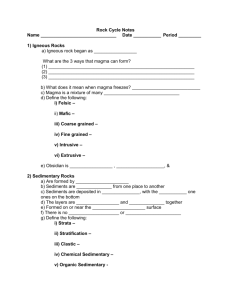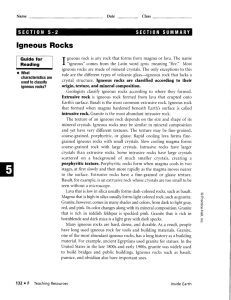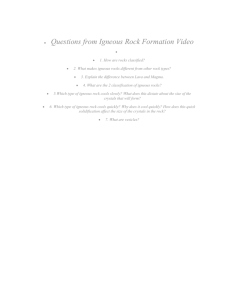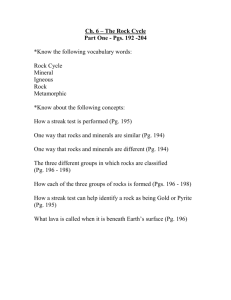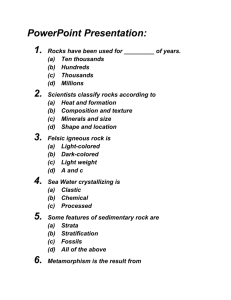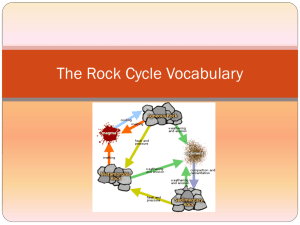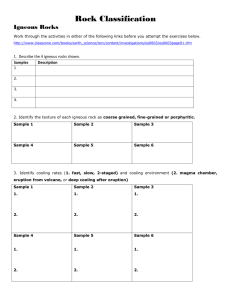Families of Igneous Rock
advertisement
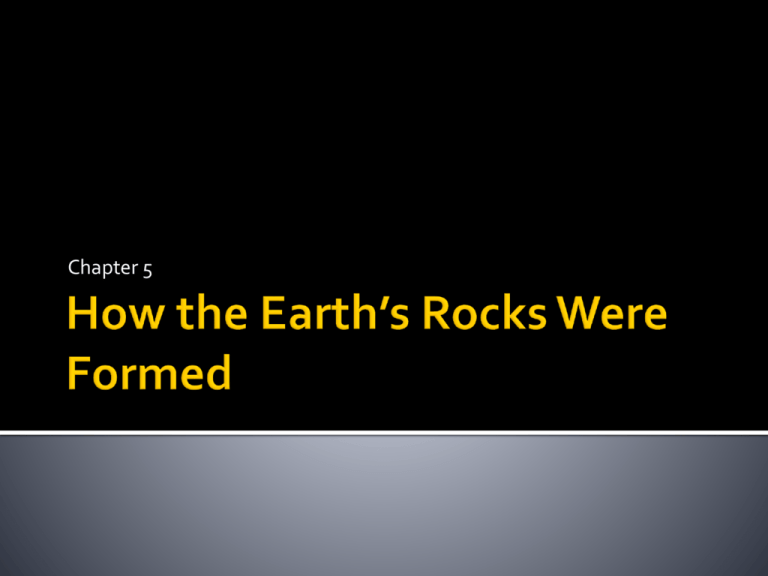
Chapter 5 Explain the principle of uniformitarianism and relate it to the formation of igneous, sedimentary, and metamorphic rocks. Discuss the differences between plutonic and volcanic igneous rock. Define rock texture and list some factors that control the texture of igneous rock. Name and describe members of the granite, diorite, and gabbro igneous rock families Modern geology began in 1795 This is when Scottish geologist James Hutton described a new concept called uniformitarianism Before Hutton goelogists thought Earth was formed by spectacular events and catastrophes They believed these catastrophies formed mountains, canyons, waterfalls and almost all land forms James Hutton’s ideas were different. He came to the conclusion, “the present is the key to the past” This statement has 2 key concepts 1. The geological process now at work were also active in the past 2. The present physical features of Earth were formed by these same processes, at work over long periods of time For example: a river valley Otheres would describe this as a sudden split of the Earth’s crust Hutton explained it as the slow steady wearing away of the land by the river over thousands of years A rock is defined as a group of minerals bound together in some way. Using Hutton’s principle, and studying different rocks around the Earth goelogists have concluded all rock from the earths crust is formed in one of 3 ways Igneous Rock – formed by the cooling and hardening of magma from inside the earth. Magma is hot molten rock (under surface). Sedimentary rock –formed by hardening and cementing of layers of sediments. Sediments may consist of rock fragments, plant and animal remains, or chemicals that form on lake and ocean bottoms. Metamorphic Rocks – formed when rocks that already exist are changed by heat and pressure into new rocks. Garnet is an example Plutonic, or intrusive, igneous rock Rocks that form underground from cooled magma These rocks are seen on the surface only after the rocks that cover them are cleared away. Example: Granite Volcanic, or extrusive, igneous rock Magma that pours onto the earths crust during a volcanic eruption is called lava These rocks are formed when the lava cools They can also be formed out of the dust and ash of a volcanic eruption Volcanic rock example: Scoria – formed from lava slowly cooling Plutonic and volcanic rocks are simular in mineral composition, but volcanic rocks lack mineral grains Example: obsidian – volcanic rock formed from lava cooling rapidly There are 2 general kinds that are most common 1. Felsic 2. Mafic Felsic when hardens forms rocks with mainly light coloured minerals high-silica Does not have much clacium, iron or magnesium Thick and slow flowing magma Felsic Granite is a common felsic rock It contains light coloured minerals like quartz and orthoclase Most plutonic rocks are felsic Mafic Low percentage of silica Higher percentage of calcuim, iron, and magnesium Magma is hotter, thinner, and more fluid than felsic When solid forms rocks with dark ferromagnesian minerals Mafic An example is basalt It contains a number of dark minerals like hornblende, augite, and biotite Most volcanic rock are mafic. Texture is another way to group rocks. A rock’s texture depends on the size, shape, and arrangement of it’s mineral crystals. Igneous rock textures range from glassysmooth (obsidian), to course grained (granite). Crystal size is most important for texture. This depends on how fast the magma hardens. The amount of gas dissolved in the magma COARSE-GRAINED TEXTURE Magma deep within the crust cools slowly Creates large mineral grains of fairly uniform size Plutonic rock has this texture Granite is an example FINE-GRAINED AND SMOOTH TEXTURE Magma that reaches the Earth’s crust as lava hardens quickly This rock has tiny crystals The crystals are too small to see without a microscope Volcanic rock like basalt is fine-grained; obsidian is glassy Porphyry (POR fur ee) rock has 2 distinctly different textures. How are these rocks formed? There are 2 stages of cooling 1. Magma is at a large depth, and here is cools slowly so large crystals can form of one mineral, the rest remains liquid 2. As the magma gets closer to the surface the rest of the magma cools into fine grained rock around the larger crystals Igneous rock is grouped into families according to mineral composition Granite Family Gabbro Family Diorite Family And some igneous rocks don’t fit into any of these families Granite Family Forms from felsic magmas Consist mainly of orthoclase feldspar and quartz ▪ These are light in colour, so the rocks in this family are usually light-coloured other minerals likely present are plagioclase feldspar, mica, and hornblende Rocks in this family will have different textures, but simular chemical compositions GRANITE FAMILY Course grained granite GRANITE FAMILY Fine-grained rhyolite GRANITE FAMILY Glassy obsidian GRANITE FAMILY Gabbro Family Forms from mafic magma Made mainly of dark plagioclase feldspar and augite Other likely minerals are olivine, hormblend, and biotite. These are generally darker and more dense than those found in the granite family GABBRO FAMILY Course-grained gabbro GABBRO FAMILY Fine-grained basalt Gabbro Family Glassy example: basalt glass Diorite Family Composition and colour between the granite and gabbro families DIORITE FAMILY Diorite: Course-grained Has less quartz than granite Has less dark plagioclase than gabbro DIORITE FAMILY Andesite: fine-grained Some igneous rock do not fit into any of these 3 families. DON’T FIT Granodiorite DON’T FIT Course grained rock Pyroxenite – nearly all pyroxene Composition between granite Coarse, dark and heavy and diorite May be like rock in Earth’s mantle DON’T FIT Dunite – almost all olivine DON’T FIT Coarse, dark and heavy Peridotite – a mix of pyroxene and olivine May be like rock in Earth’s Coarse, dark and heavy mantle May be like rock in Earth’s mantle Granite Made of: ▪ quartz – looks like tiny chips of cloudy or grayish glass ▪ orthoclase feldspar – often has smooth cleavage surfaces and is white, gray, pink or orange ▪ and one other mineral like mica (shiny black flakes) or hornblende (tiny dull black chunks or sticks) Ranges in colour from light to medium gray and pinks Have course-grained texture Granite The most common continental igneous rock Occurs in thr Rockies, the Aairondacks of New York State, the Black Hills in South Dakota, the White Mountains of New Hampshire, and in many other mountain areas It is plutonic, and when it appears on the surface it shows errosion removed thousands of meters or rock since the magma cooled Granite Felsite is the general name for light-coloured, fine grained granite Rhyolite is an example of a fine-grained, light gray to pink rock Obsidian Volcanic glass of the granite family ▪ Contains many of the same minerals and other light coloured rocks like granite Usually dark brown or black ▪ This is due totiny amounts of dark coloured minerals scattered throughout the rock Is hard and brittle It has a conchoidal, or shell-like, fracture Pumice Formed from felsic lava that hardened while steam and other gases were still bubbling out of it It looks like a sponge with many small holes in it Because of all the air holes, it is sometimes light enough to float on water Basalt The most common rock in the gabbro family A fine-grained rock Ranges in colour from dark green to black Basalt is the igneous rock on the ocean floor On land it is the most common rock formed from flows of lava Large areas occur in the lava flows of: Iceland, Hawaiian Islands, and Columbia and Snake River in western United States Gabbro Has about the same composition as basalt It is cooled slowly deep underground, so it is course-grained Very dark in colour Diabase Has a composition simular to gabbro It has a finer texturethan gabbro, but courser than basalt Basalt Glass Is like obsidian, but has a mafic composition Scoria Is full of holes like pumice Is made of denser material than pumice, so not all scoria floats Page 68 number 1 to 8
